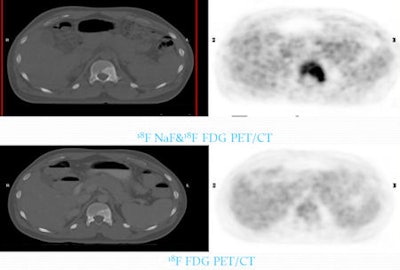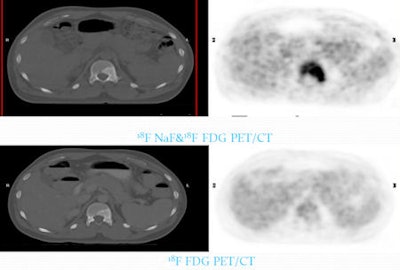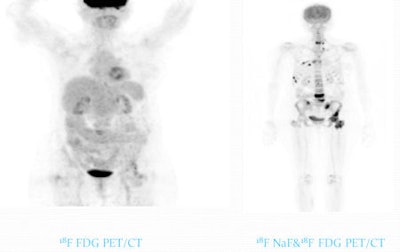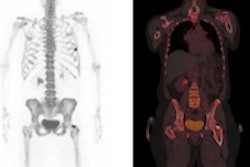
Researchers at Stanford University in Stanford, CA, are finding that the combination of FDG and F-18 sodium fluoride (NaF) with PET/CT increases sensitivity for detecting malignant lesions when compared to FDG alone.
Preliminary results also showed that dual-tracer imaging can achieve optimal results by administering the second tracer within approximately two hours of the first tracer injection, or by combining the two tracers as a "cocktail" of FDG and NaF.
"FDG-PET/CT and sodium fluoride PET/CT give different information, and they are typically done as two separate exams in two different patient visits," said lead author Frank Lin, MD, a PET/CT fellow at Stanford. "If you combine the two tracers into a single scan [and give] the patient a 'cocktail' tracer of FDG and sodium fluoride at the same time, can you obtain the clinical information of both scans with the convenience of a single scan?"
Tracer dosage
The prospective study, presented at the 2010 RSNA meeting, imaged 40 patients (28 men, 12 women; average age, 52.1 years) with a known history of cancer. All patients received both a conventional PET/CT scan (15 mCi of FDG) and a dual-tracer study (15 mCi of FDG and 5 mCi of NaF).
Twenty-nine (73%) of the 40 patients received simultaneous tracer injections, while 11 patients (28%) were injected with NaF a few hours after receiving the initial FDG dose. The average time between injections for those 11 patients was 137 ± 26 minutes.
Images were independently reviewed by two board-certified nuclear medicine physicians for PET findings, with discrepancies resolved by a third reader. The readers also were asked to only report findings that likely represented pathology. Lin and colleagues controlled a potential order bias by having the FDG-only PET/CT scans read first for half of the patients.
 |
| Images of a 32-year-old man show noncontrast CT and FDG-only PET images (bottom panel) of a sclerotic lesion in a thoracic vertebra with no apparent increased FDG uptake. The top panel shows the same lesion imaged with FDG and NaF, which detects increased uptake on the PET image. |
The review of images found that nine of the 40 scans were scintigraphically negative, while one exam was excluded due to a technical question regarding the FDG injection in the dual-tracer study.
Of the remaining 30 scans, the cocktail tracer detected a greater number of lesions in eight cases (27%) compared to the FDG-only scan. "Overall, in 38 of 39 [97%] patients, the dual-tracer scan detected the same or greater number of lesions compared against the FDG-only scan," Lin said.
In one case, the cocktail tracer scan did not detect a lesion in the mediastinal lymph nodes, which was discovered by the FDG-only scan. However, Lin noted that other lesions within the mediastinal lymph nodes were seen, so the omission did not adversely affect patient staging.
In addition, the researchers concluded that there were no clinically significant differences between the dual-tracer scans done simultaneously or as separate injections.
 |
| A 52-year-old woman with breast cancer imaged with FDG-only (left) with no lesions suspicious for malignant involvement identified. The cocktail tracer (right) demonstrated multiple foci of increased tracer activity suggestive of osseous metastases. |
"The cocktail scan has the same caveats as traditional bone scans in that it is more sensitive than specific," Lin said.
Because of the way the study was designed regarding histological correlation of the new lesions detected with the cocktail tracer, the researchers did not have pathology follow-up to determine if there were true positives.
By Wayne Forrest
AuntMinnie.com staff writer
January 21, 2011
Related Reading
F-18 NaF PET/CT can help with atherosclerotic plaque detection, June 11, 2010
CMS OKs F-18 NaF imaging coverage, March 8, 2010
F-18 fluoride PET/CT may better manage painful bone metastases, November 29, 2009
Sodium fluoride PET/CT changes management of foot pain patients, November 3, 2009
Copyright © 2011 AuntMinnie.com




















